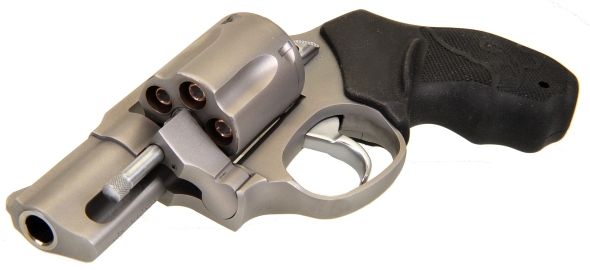
We’ve reviewed a number of Taurus products with good results. The Model 605 2″ 357 Mag is another well made firearm, cleanly finished and reliable in operation although the 357 Mag is a lot of cartridge for a compact, short barrel revolver. Personally, it hasn’t been a combination I’ve used a good deal mostly because it seems to give up the biggest benefit a revolver can offer, velocity that interprets into power. This seemed like a good time to take a look at a good compact revolver and better qualify the issues of power tradeoffs for compact carry.
|
Taurus Small Frame Model 605SS2 |
|
| Manufacturer | Taurus |
| UPC# | 7-25327-20302-5 |
| Country of Origin | Brazil |
| Type | Double – Single Action |
| Actuation | Trigger – Exposed Hammer |
| Caliber | 357 Mag |
| Capacity | 5 |
| Barrel Length | 2.0“ |
| Rifling | 1:16.5″ RH |
| Weight | 24 Oz. |
| Overall Length | 6.50″ |
| Grips | Shock Absorbent Rubber |
| Material | Stainless Steel |
| Rear Sight | Grooved Top Strap |
| Front Sight | Integral Ramped Blade |
| Trigger Pull DA/SA | 12.2 lbs/4.7 Lbs |
| MSRP | $501 |
|
Taurus Key and Transfer Bar Safety Systems |
|
It seems the important thing to do is to not to draw a comparison with a large frame revolver. There are numerous compromises to be made in exchange for ease of concealment so a compact revolver will not bode well in comparison to an N frame like revolver. The little revolver has a two finger grip which will inevitably draw the “I have big hands so I need bigger grips” as though there is something wrong with the revolver. Realistically, it is a concealment piece which means small size so even the average person must learn to shoot one or two handed with only two fingers on the grip.
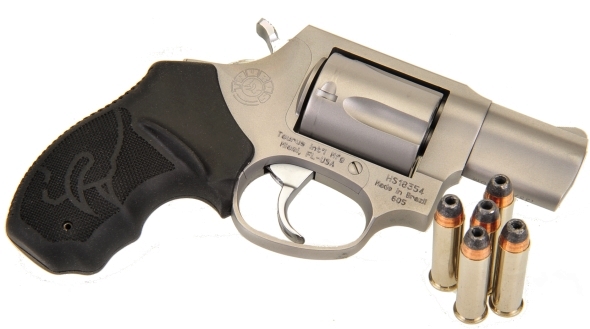
The trigger pull is curious. Double action is heavy and resistance builds progressively to 12 Lbs. A smooth even pull gets smooth even results. It is fairly easy to index the cylinder and cock the hammer with the trigger poised to released the sear with very little travel. At the last point there is no more take up and little creep before the hammer falls. But slow down a bit and the early resistance from cocking the hammer becomes uneven with increasing resistance and an inability to pause before the hammer falls. Single action operation is clean, crisp and light making the exposed hammer a welcome feature.
The cylinder locks up tightly at two points with the trigger pulled and the hammer down. Cylinder gap measured a tight 0.005″. Cylinder endshake checked less than 0.001″. Cylinder/bore alignment checked good with a range rod. All cylinder parts rotated or pushed freely as appropriate and the yoke lined up cleaning with the frame when closed. As I said, a well make little revolver.

The sights are non-adjustable, which is traditional for this type of firearm as it is meant to be a point and shoot, close in defense. I don’t care for fixed sights because they can’t easily be adjusted for shifts in point of impact, so it makes checking mechanical accuracy a pain in the neck. In actual use, inside 10 yards, no one looks at them anyway.
After putting a lot of 38 Special, 38 Special +P and high velocity 357 Mag ammo through the Taurus, it felt about the same. Nothing shot or wore loose. Some loads shot very mild, some not so much with a considerable amount of muzzle blast, flash and report – fun. Yes, there is upward rotation, little shock is transferred to the wrist so there is little shooting fatigue. Over the time I spent with the revolver, I learned to like it, which is typically not in my stubborn nature. So I decided to wring out its performance a bit more, examine the external and terminal ballistics of this short barrel gun and be in a better position to assess its worth.
2″ barrel versus 4″ barrel
People often say that the gains from a magnum round are negated by a short barrel, and that it might make sense to begin with a lesser cartridge. What people? The people who send angry email and tell me to stop writing about .500 S&W short barrel revolvers… or else.
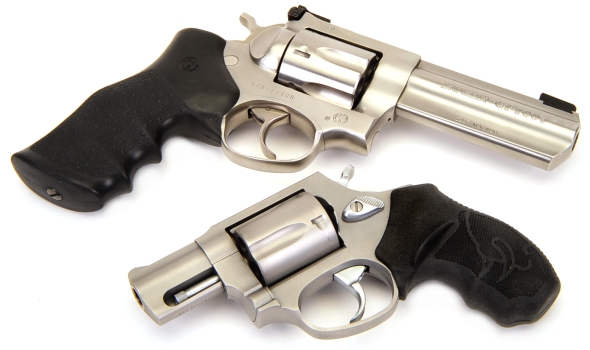
While I am sure all of my theories and conjecture are all spot on, it seemed reasonable to take a closer look with use of a chronograph, video camera and ballistic Gel. We will break this into two or three segments; exterior ballistics, terminal ballistics and then logical summation.
| 357 Mag Ammunition | Grains | *Mfg. Test Barrel Length” |
Rated Velocity FPS |
2″ Actual FPS |
Rated to 2″ Delta |
4″ Actual FPS |
4″ to 2″ Delta FPS |
| Remington HTP** | 180 | 8 3/8 V | 1145 | 1033 | -112 | 1172 | -139 |
| Hornady Custom XTP | 158 | 8 V | 1250 | 1097 | -153 | 1254 | -157 |
| * V= Vented barrel to simulate a revolver’s cylinder gap ** Only 180 grain 357 Mag is 8 3/8″. All other weights 4″. |
|||||||
It is interesting to note the conservative ratings for the factory ammunition where the 4″ barrel outperformed the 8″ test barrels in terms of muzzle velocity. In any event, the velocity loss associated with the 2″ barrel is significant. So what about dropping down to the next level of cartridge and hopefully gaining through greater efficiency? Two popular loads for the 38 Special –
| 38 Spl Ammunition | Grains | *Mfg. Test Barrel Length” |
Rated Velocity FPS |
2″ Actual FPS |
Rated to 2″ Delta |
4″ Actual FPS |
4″ to 2″ Delta FPS |
| Remington HTP +P ** | 110 | 4 V | 995 | 873 | -122 | 1044 | -171 |
| Hornady Custom XTP | 158 | 4 V | 800 | 728 | -72 | 785 | -57 |
| * V= Vented barrel to simulate a revolver’s cylinder gap ** Only 180 grain 357 Mag is 8 3/8″. All other weights 4″. |
|||||||
Even with reduced bullet weight and +P charges, the 38 Special can’t come close to the 357 Magnum even when barrel length is reduced to 2″. Even at weight difference extremes, the 357 Magnum’s 180 grain load is 160 fps faster than the 110 grain +P 38 Special load. At equal 158 grain bullet weights, same brand, same type, the 357 Magnum is 369 fps faster than the 38 Special.
All of the loads noted above meet the velocity requirements for proper bullet expansion, approximately 700 fps to 1400 fps MV. Missing is penetration and expansion assessment which is needed to make the information useful. That will be included in Part 2. While the 357 Magnum, 158 grain load looks stellar, perhaps the standard velocity 38 Special load provides sufficient lethality?
What about other bullet types and handloads?
I picked three bullets that are popular with 357 loads, each of a different weight or construction. The pair of bullets on the right are both 158 Hornady XTP bullets, the first an HP/XTP, the far right the FP/XTP. The XP version has a MV range to assure expansion from 700 fps to 1400 fps. The FP version’s range is 1150 fps to 1800 fps… a virtual paper punch at 1100 fps.
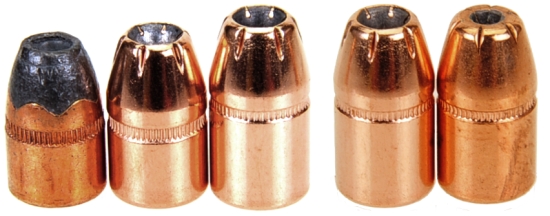
| Bullet | Type | Weight | Length | MV Range FPS |
| Remington | SJHP | 125 | 0.572 | 700 – 1300 |
| Hornady | HP/XTP | 140 | 0.600 | 850 – 1600 |
| Hornady | HP/XTP | 158 | 0.670 | 700 – 1400 |
The hand load data below indicates actual velocity for both the 2″ Taurus and 4″ barrel Ruger. All of the loads were assembled to 1.590″ and all received standard small pistol primers. Fast, moderate and slow burn rate powers were used as part of the assessment and the truth of the matter is, there is no consistent trend in velocity, accuracy or barrel length velocity disparity.
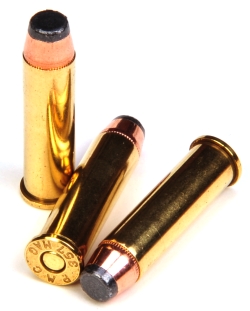 |
Warning: Bullet selections are specific, and loads are not valid with substitutions of different bullets of the same weight. Variations in bullet length will alter net case capacity, pressure and velocity. Primer selection is specific and primer types are not interchangeable. These are maximum loads in my firearms and may easily be excessive in others. All loads should be reduced by 5%, and developed following safe handloading practices as represented in established reloading manuals produced by component manufacturers. Presentation of these loads does not constitute a solicitation for their use, nor a recommendation.
|
||||||||||||||||||||||||||||||||||||||||||||||||||||||||||||||||||||||||||||||||||||||||||||||||||||||||||||||||||||||||||||||||||||
|
|||||||||||||||||||||||||||||||||||||||||||||||||||||||||||||||||||||||||||||||||||||||||||||||||||||||||||||||||||||||||||||||||||||
Going in, I guessed there would be a loss of velocity as powder slowed and unburned powder leaving the muzzle percentages increased, yet the slowest powder, with the heaviest bullet delivered the highest velocity for the 158 grain bullet for both the 2″ and 4″ barrels. Would any of this deter me from buying a short barrel revolver? Not really, or at least not yet. Part 2 should make for a better determination. Turn in next week. Same place… same bat time…
The Taurus Model 605… Snubby Part 1
The Taurus Model 605… Snubby Part 2

Email Notification